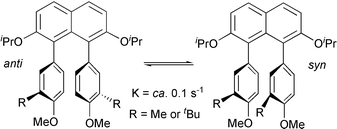The structure, modelling and dynamics of 2,7-diisopropoxy-1,8-diarylnaphthalenes
Abstract

a Department of Chemistry, University of Durham, Science Laboratories, South Road, Durham, UK
b Department of Chemistry, Queen Mary, University of London, Mile End Road, London, UK
c New address: Molecular Modelling & Design, Discovery Research Oncology, Pharmacia, Viale Pasteur 10, 20014 Nerviano (MI), Italy
d Institute of General, Inorganic and Theoretical Chemistry, University of Innsbruck, Innrain 52a, A-6020 Innsbruck, Austria
e Department of Chemistry, U.M.I.S.T., PO Box 88, Manchester, UK

 Please wait while we load your content...
Something went wrong. Try again?
Please wait while we load your content...
Something went wrong. Try again?
C. Thirsk, G. E. Hawkes, R. T. Kroemer, K. R. Liedl, T. Loerting, R. Nasser, R. G. Pritchard, M. Steele, J. E. Warren and A. Whiting*, J. Chem. Soc., Perkin Trans. 2, 2002, 1510 DOI: 10.1039/B201235A
To request permission to reproduce material from this article, please go to the Copyright Clearance Center request page.
If you are an author contributing to an RSC publication, you do not need to request permission provided correct acknowledgement is given.
If you are the author of this article, you do not need to request permission to reproduce figures and diagrams provided correct acknowledgement is given. If you want to reproduce the whole article in a third-party publication (excluding your thesis/dissertation for which permission is not required) please go to the Copyright Clearance Center request page.
Read more about how to correctly acknowledge RSC content.
 Fetching data from CrossRef.
Fetching data from CrossRef.
This may take some time to load.
Loading related content
